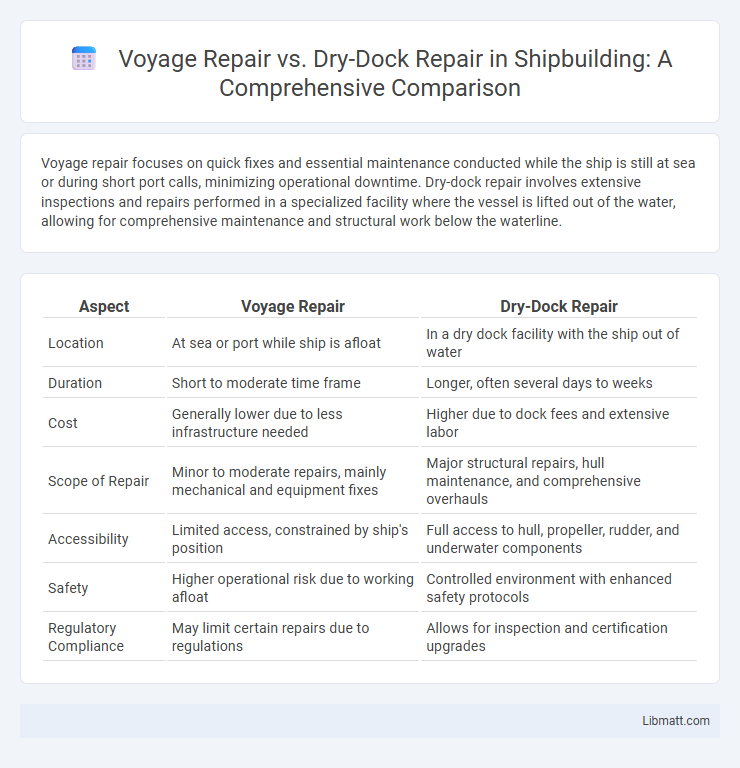Voyage repair focuses on quick fixes and essential maintenance conducted while the ship is still at sea or during short port calls, minimizing operational downtime. Dry-dock repair involves extensive inspections and repairs performed in a specialized facility where the vessel is lifted out of the water, allowing for comprehensive maintenance and structural work below the waterline.
Table of Comparison
| Aspect | Voyage Repair | Dry-Dock Repair |
|---|---|---|
| Location | At sea or port while ship is afloat | In a dry dock facility with the ship out of water |
| Duration | Short to moderate time frame | Longer, often several days to weeks |
| Cost | Generally lower due to less infrastructure needed | Higher due to dock fees and extensive labor |
| Scope of Repair | Minor to moderate repairs, mainly mechanical and equipment fixes | Major structural repairs, hull maintenance, and comprehensive overhauls |
| Accessibility | Limited access, constrained by ship's position | Full access to hull, propeller, rudder, and underwater components |
| Safety | Higher operational risk due to working afloat | Controlled environment with enhanced safety protocols |
| Regulatory Compliance | May limit certain repairs due to regulations | Allows for inspection and certification upgrades |
Introduction to Maritime Repairs
Voyage repairs involve on-site maintenance conducted while a ship remains operational, minimizing downtime and allowing for immediate correction of minor faults. Dry-dock repairs require the vessel to be taken out of the water, enabling comprehensive inspections, structural repairs, and overhauls that cannot be done during active service. Choosing between voyage repair and dry-dock repair depends on the severity of damage, cost considerations, and scheduled maintenance timelines in maritime operations.
Defining Voyage Repair
Voyage repair refers to maintenance and minor repairs performed on a vessel while it remains operational and underway, often at sea or during port calls, without removing the ship from service. This type of repair addresses urgent or routine issues using onboard resources or service providers that can operate alongside the vessel. Voyage repair minimizes downtime and avoids the significant costs and logistics associated with dry-dock repair, which requires the ship to be taken out of water for extensive inspection and overhaul.
Understanding Dry-Dock Repair
Dry-dock repair involves completely lifting a vessel out of the water to access its hull and underwater components, allowing for thorough inspections, maintenance, and structural repairs that cannot be performed during voyage repairs. This process is essential for tasks like hull cleaning, propeller maintenance, and deeper structural assessments, ensuring the vessel's longevity and compliance with maritime safety regulations. Your choice between voyage and dry-dock repairs depends on the extent of maintenance needed, with dry-dock offering a comprehensive solution for long-term vessel health.
Key Differences Between Voyage and Dry-Dock Repairs
Voyage repair involves maintenance and minor repairs conducted while the vessel is operational and at sea, focusing on quick fixes to avoid operational downtime. Dry-dock repair requires the vessel to be taken out of water and placed in a dry dock, enabling comprehensive inspections, structural repairs, and maintenance that cannot be performed afloat. The key differences lie in scope, duration, and operational impact: voyage repairs are limited in scale and time-efficient, while dry-dock repairs allow for extensive overhauls but necessitate significant vessel downtime.
Common Types of Voyage Repairs
Common types of voyage repairs include emergency hull patching, machinery troubleshooting, and propulsion system adjustments performed while the vessel remains operational at sea. These repairs typically address issues like minor hull breaches, engine overheating, and propeller damage to prevent further deterioration before reaching a port. Quick fixes such as valve replacements, electrical rewiring, and pump repairs are also frequent voyage repair tasks that ensure continued vessel safety and functionality.
Typical Dry-Dock Repair Procedures
Typical dry-dock repair procedures involve scheduling the vessel's removal from water, draining the dock, and securing the ship on keel blocks for inspection and maintenance. Engineers and technicians perform extensive hull cleaning, painting, structural repairs, and machinery overhauls that cannot be done while afloat. You benefit from dry-dock repairs with comprehensive restoration and compliance to classification society regulations, ensuring vessel safety and operational efficiency.
Cost Implications: Voyage vs Dry-Dock Repair
Voyage repair typically incurs lower immediate costs as it avoids the extensive downtime and labor expenses associated with dry-dock procedures, making it suitable for minor maintenance or emergency fixes. Dry-dock repair involves higher upfront expenses due to the need for specialized facilities, prolonged vessel immobilization, and comprehensive inspections, but it offers thorough maintenance that can prevent costly future repairs. Shipowners must weigh the cost benefits of quick voyage repairs against the long-term savings and regulatory compliance offered by dry-dock overhauls.
Time Considerations and Operational Impact
Voyage repair typically requires less time than dry-dock repair, allowing vessels to resume operations with minimal delay and maintain schedule adherence. Dry-dock repair demands extended downtime due to the vessel being taken out of service for thorough maintenance, which can significantly disrupt operational timelines. Choosing between the two depends on your vessel's urgency for repairs and the acceptable level of operational impact on your shipping schedule.
Regulatory and Safety Compliance
Voyage repair ensures continuous regulatory and safety compliance by enabling prompt maintenance without disrupting vessel operations, aligning with SOLAS and MARPOL standards. Dry-dock repair allows for comprehensive inspections and repairs of critical structural components, facilitating adherence to classification society rules and international safety management codes. Both methods require strict documentation and certification to meet port state control and flag state requirements.
Choosing the Right Repair Method for Your Vessel
Voyage repair offers immediate, cost-effective fixes while the vessel remains operational, reducing downtime and minimizing schedule disruptions. Dry-dock repair provides comprehensive maintenance and structural inspections, essential for addressing major hull, propeller, or engine work that voyage repairs cannot cover. Selecting the right repair method depends on the severity of damage, operational urgency, and long-term vessel maintenance strategy to ensure safety and regulatory compliance.
Voyage repair vs dry-dock repair Infographic

 libmatt.com
libmatt.com